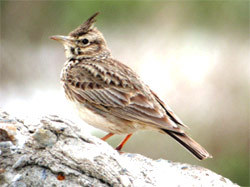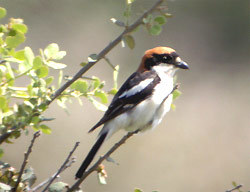One Day Tours
Ronda and the upper reaches of the Rio Guadario
 An early start is required for this tour as we have to travel 30 kilometers to Ronda to begin with. This historic town sits the edge of a sheer bluff some 700 meters above sea level and straddles the precipitous Tajo Gorge. Standing on the Puente Nuevo overlooking the gorge you see a sheer drop and is enough to impress even the most worldly of travellers.
An early start is required for this tour as we have to travel 30 kilometers to Ronda to begin with. This historic town sits the edge of a sheer bluff some 700 meters above sea level and straddles the precipitous Tajo Gorge. Standing on the Puente Nuevo overlooking the gorge you see a sheer drop and is enough to impress even the most worldly of travellers.
The birds are impressive too, good close views can be had of Lesser Kestrel, and Red-billed Chough, whilst other species such as Blue Rock Thrush, Rock Sparrow, Rock Bunting, Crag Martin, Alpine and Pallid Swifts can often be seen here. Ravens, Kites, Vultures and Eagles can be seen overhead and the Barn Swallows are joined by Red-rumped Swallows.
In complete contrast to the hustle bustle of the busy tourist trap of Ronda our next stop, to the west of Ronda, is beautiful tranquil countryside just above Montejaque. After passing through rolling hills and farmed valleys we reach a large seasonal reservoir, seated in the valley, Dehesa la Laguna. A short walk from the roadside there is a dam where we can look for Black Wheatear, black Redstart, White-rumped Swift, Shrikes, Finches and Buntings.
 We then drive through a steep sided and rugged mountain pass, Puerto de Tabizna, the scenery is magnificent here and we may glimpse Blue rock Thrush and Black Wheatear from the car. Soon we come to the upper reaches of the Rio Guadario and there we will take a riverside walk, with forest on one side and the river on the other. There we may see a good variety of species. Woodland birds such as: Short-toed Treecreeper, Jay, Wren, Golden Oriole, Flycatchers, Titsand Finches.
We then drive through a steep sided and rugged mountain pass, Puerto de Tabizna, the scenery is magnificent here and we may glimpse Blue rock Thrush and Black Wheatear from the car. Soon we come to the upper reaches of the Rio Guadario and there we will take a riverside walk, with forest on one side and the river on the other. There we may see a good variety of species. Woodland birds such as: Short-toed Treecreeper, Jay, Wren, Golden Oriole, Flycatchers, Titsand Finches.
A walk through a Cork Oak woodland may turn some interesting species, these ancient woodlands hold some very interesting species, which include Bonelli's, Subalpine and Orphean Warblers, there are also Short-toed Treecreeper, Eurasian Nuthatch, Golden Oriole, Firecrest & Mistle Thrush. Overhead we may see raptors, swifts, swallows and martins.
 Further down the valley we can pull in and walk up to the entrance of the Cueva de la Pileta, a series of caves that contain Neolithic paintings.
Further down the valley we can pull in and walk up to the entrance of the Cueva de la Pileta, a series of caves that contain Neolithic paintings.
The views are stunning here and the scrub of the mountainside holds Dartford, Subalpine and Sardinian Warblers. Raptor watching can be particularly good from this point.
Continuing our southerly journey we pass through beautiful landscapes with the Sierra del Palo alongside us, we will make many stops to scan the barren rock face and the scrub area that leads down towards the river. Finally we arrive at Libar where we will take our final walk of the day. Again a good variety of species will be seen and we have the opportunity there to fill in any gaps on our tick list for the day.
